In the ever-changing world of online poker, mastering Pot-Limit Omaha Multi-Table Tournaments (MTTs) can significantly enhance your game and improve your winrate.
PLO tournaments are a widely unexplored facet of PLO strategy. Most PLO players are cash game players and not tournament professionals because there simply isn’t enough tournament volume to grind full-time.
Whether you’re transitioning from cash games or looking to freshen up your poker strategy, understanding the nuances of PLO MTTs is crucial. This article provides a comprehensive guide on how to excel in these tournaments, from preparation to in-game tactics, ensuring you’re well-equipped to tackle your next poker event.
Why play PLO tournaments? In the following clip, JNandez talks about on of the differences between PLO cash games and PLO tournaments.
Every Situation is Unique in MTTs
In cash games, the table setup tends to follow a more standardized pattern. However, Multi-Table Tournaments (MTTs) present a different scenario altogether. In MTTs, the complexity of strategies is heightened due to the varying stack sizes, player ranges, and the implications of the Independent Chip Model (ICM).
This complexity means that many opponents may not have studied certain scenarios as deeply as they might in cash games, where the most common situations are better understood and more frequently encountered.
These added complexities inherent in MTTs have the potential to either amplify or diminish a player’s edge, depending on the level of commitment to studying the game. Dedication to understanding and adapting to the dynamic nature of tournaments can significantly enhance a player’s performance and strategic acumen.
Moreover, there tends to be fewer specialists in MTTs compared to cash games, and the vast array of possible game situations in tournaments makes it challenging to study each scenario in depth. This gap in comprehensive knowledge emphasizes the importance of experience and adaptive skill sets in tournament play.
Rake Considerations
One of the most significant differences between Multi-Table Tournaments (MTTs) and cash games in Omaha poker is the upfront payment of rake. In MTTs, the rake is included in the tournament entry fee, meaning there’s no ongoing rake deduction from each hand played—contrary to the structure commonly seen in cash games.
The absence of a per-hand rake in PLO MTTs leads to significant adjustments in gameplay, especially for players transitioning from cash games. These strategic adjustments can dramatically influence how you approach the game, especially when considering when and how to enter tournaments for maximum profitability.
For instance, registering early with a full stack (100BB) might give you a significant edge. Conversely, entering a tournament late with a shorter stack might reduce your ability to cover the rake effectively, suggesting a need to reconsider your participation or strategy at that stage.
An exception to this rule can occur if you register at the very last minute when many players have already been eliminated. In such cases, even starting with a smaller stack might still yield positive ICM (Independent Chip Model) implications, as a single double-up could position you near the average stack size, enhancing your chances for a deeper run.
In cash games, you are less incentivized to see a flop because you are going to pay rake on every single board that comes off, but you’re not going to pay rake if you win the hand pre-flop. That’s not the case in tournaments, therefore you have more incentive to see the flop and move your edges towards the post-flop situations, and you do that much more by limping.
Expanded Hand Ranges and Increased VPIP
With no rake on individual hands, players can afford to play a wider range of hands, leading to a higher Voluntarily Put In Pot (VPIP):
- Marginal Hands Become Playable
In cash games, the rake often renders marginal hands unprofitable. However, in a rake-free tournament environment, these hands gain value, allowing players to engage more freely. - Increase in Cold Calling
The elimination of rake encourages a higher frequency of cold calling. Passive play generally becomes more viable in tournaments, altering the dynamics at the table.
- Reduced 3-Betting
Given the modified risk-reward structure without rake, players tend to 3-bet less frequently. The decreased fold equity in tournaments makes continuing with a wider range of value hands more appealing. - Antes act as Reverse Rake
Instead of the pot being reduced by rake, antes add to the pot, effectively giving players free money to compete for at the start of each hand. This setup encourages players to participate in more hands to capitalize on the extra chips available. - The Strategic Use of Limping
Limping, often viewed negatively in cash games, becomes a strategic tool in tournaments. Constructing a limping range from all positions can be crucial, especially in balancing play without over-committing chips. Ideal limping hands are those which might typically raise and call a 3-bet but are less favorable under short stack conditions.
Shallow Stack Sizes
When you play a shorter stack, the quality of your starting hand matters a lot more than when you are deeper stacked, so you have to be more selective. Position and deceptiveness also matter more. Overall, you don’t want to open raise as many hands and you don’t want to 3-bet as loose.
If you are raising full pot, it commits a bigger portion of your complete stack, and therefore you have to be careful with this action.
It’s standard in cash games, but when you play tournaments, you should raise smaller to risk less of your complete stack to have a higher SPR. But also, when you’re facing a 3-bet and you’re not holding a great hand you can still fold or call without committing too much of your stack pre-flop.
There are also some benefits to raising smaller. Maybe your opponents are over-folding, playing too many hands, and you get to the flop with a smaller investment, which is going to bring more of the gameplay to post-flop streets.
The reason you don’t want to commit a large part of your stack preflop is that a lot of the edges that you generate are going to come from your post-flop advantages, specifically against players that are not that familiar with PLO.
In the following clip, I talk about ultra short-stack strategy, which refers to having 10 big blinds or lower, and why it’s such an important aspect of tournament strategy.
When you are approaching or are past the bubble (the point in the tournament where the last player without a prize goes bust), you do not want to employ as loose of a strategy as suggested in the previous clip.
In fact, oftentimes when stacks are low all over the place, you want to be careful and play tight when you are dealing with pay jumps, such as in the final table.
ICM
Discussing the Independent Chip Model (ICM) is essential in any comprehensive guide on MTTs, particularly in PLO, where it remains less explored compared to Texas Hold’em. ICM requires a nuanced understanding of how the value of your chip stack translates into real money potential, which is crucial for making strategic decisions in tournaments.
One of the fundamental concepts of ICM is that doubling your chips does not necessarily double your tournament equity in terms of dollar value. Similarly, increasing your stack size provides a smaller incremental monetary gain compared to the significant monetary loss incurred by losing an equivalent number of chips. This disproportionate risk encourages a more conservative approach to gameplay when considering ICM, especially in crucial decision-making moments.
Moreover, the impact of ICM is not limited to the bubble phase of a tournament. It’s a constant presence, growing in importance as you approach significant payout jumps. Understanding that ICM implications begin well before the bubble—and that their influence only increases as you get closer to larger cashes—is key to effective tournament strategy.
Additionally, not all chips in your stack carry the same value. The last few chips in your stack are typically worth much more than individual chips held while possessing a large stack. This valuation becomes particularly critical when nearing a pay jump and you find yourself with a smaller stack—for example, having 1,000 chips when another player has only 500 can drastically change the strategic considerations due to ICM.
Most Common Mistakes
A key aspect of mastering PLO MTTs is avoiding common strategic errors that can diminish your chances of success. Addressing these mistakes involves a deep understanding of the dynamics at play in PLO MTTs:
- Lack of Stack Size Awareness
Many players tend to focus solely on their own stack size, applying a generic strategy that aligns with their chip count. It’s crucial to be aware of not only your own stack but also those of your competitors, especially if you’re positioned near players with significantly smaller stacks. This awareness can call for a strategic shift to capitalize on your relative strength at the table. - Playing Too Tight Preflop
Particularly in tournaments with antes, playing too conservatively preflop is a common error. Many players maintain an overly narrow 3-betting range, heavily weighted towards AA. While it’s true that our 3-betting might decrease slightly as calling becomes more profitable in rake-free situations, maintaining aggression is vital, especially when playing shorter stacks. Aggressive plays like squeezing become even more critical as they exploit the frequent cold calls that occur in an environment with no per-hand rake. - Mismanagement of ICM Pressures
Incorrectly handling ICM pressures both pre-flop and post-flop can lead to significant mistakes. Some players may call too liberally in ICM-sensitive stages, only to fold too often post-flop, particularly when up against large stacks who can exert substantial pressure.
It’s important to adjust your calling ranges and decision-making to account for the heightened value of chips in these scenarios. For example, you might find yourself with 40% equity on the flop and consider pushing all-in; however, the ICM considerations could dictate that a push would require a higher equity, perhaps around 65%, to justify the risk.
Conversely, when you hold a large stack, applying pressure and forcing opponents into tough decisions can be an effective strategy to maximize your advantage.
Conclusion
From understanding the nuances of rake implications and adapting to rake-free gameplay, to navigating the unique challenges posed by variable stack sizes and leveraging the Independent Chip Model (ICM), this article has covered critical aspects to enhance your gameplay.
Additionally, by identifying common mistakes and outlining effective strategies, we aim to not only improve your tactical approach but also boost your overall success rate in PLO MTTs. By refining your approach to address these areas, you can significantly improve your performance and outcomes in tournaments.
Happy playing, and may your strategic depth and adaptive skills bring you to the tournament tables with renewed confidence and expertise!





























